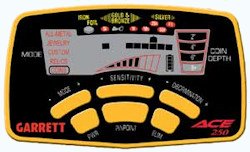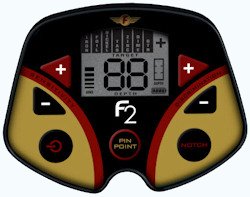GARRETT'S ACE 250 AND FISHER'S F2 - A COMPARATIVE REVIEW

Lowjiber (John)
The basic Garrett Ace 250 with a 6.5"/9" elliptical, concentric search coil currently sells for about $200. The Fisher F2 with an 8" round, concentric search coil is currently $199. The F2 warranty is 5 years, as opposed to 2 years with the Ace. Price and warranty advantage goes to the F2.

The Ace 250 uses four AA batteries, whereas the F2 uses two 9v batteries. Since neither machine has a lot of output power anyway, the difference in operating voltage is insignificant, and both seem to run 'forever' without need for battery replacement.
Both machines weigh about the same, and the swing fatigue factor is non-existent for all but the most fragile of users. Both machines operate at around 6kHz, which is ideal for coins and like targets.
The Ace 250 comes with an instructional video, one of the major reasons I often recommend it to a beginner over the F2. Along that line, the Ace 250 is actually easier to use as the masking function is enhanced by six search modes, including pinpoint, which seems to help the beginner. The F2 only offers two search modes, again, including pinpoint, leaving the beginner the daunting task of performing target notching on their own. More on this below, but it's another reason I recommend the Ace 250 to beginners. Score 2 for the Ace.

The Ace 250's display screen is tiny and very difficult to read compared to the F2. Target ID is dependent upon a tiny arrow pointing to the correct segment, whereas the F2's display is fairly large and easy to read in just about any light. Actually, the 12 ID segments of the Ace 250, compared to 7 with the F2, add to the difficulty of reading the display. Score a huge difference for the F2, display-wise.

Speaking of target ID, the F2 provides a large two-digit number along with its segment indication, similar to White's famous VDI. This can be slightly confusing to the beginner, but quickly gets the user accustomed to relating a given number with targets, just like the more expensive machines. Score one for F2.
Regarding keyboard 'buttons', I give the advantage again to the F2's 'peanut butter proof' method of placing the keys under a plastic mask to keep out dirt, water, etc. The Ace offers traditional push buttons that offer the opportunity for the aggressive user to end up with dirt in/around the keys.
The F2 has four tones that sound 'normal' when compared to the three 'dings' that the Ace 250 produces. Not a big deal, but I give half a point to the F2 because I want my detector to sound like a detector, not an ice cream truck.

Regarding pinpointing, the F2 is the big winner here. While the two standard coils are of different shapes, they're both simply concentric coils that, in theory, should pinpoint dead center. However, the Ace 250 points about 2" left-of-center. Since we want beginners to quickly develop skills necessary to allow for smaller holes, the F2 makes the job easier for the rookie.
Neither machine is very deep. Five inches is an average maximum depth on coin-size targets. The lack of ground balancing capability causes the user to really turn down the gain (sensitivity) in minerialized conditions.
From a coil availability perspective, the Ace 250 has several coils readily available, including a DD (Double D). The two major coils for the F2 are simply the 8" concentric and the 4" shooter, a dynamite coil in trash. Although, I can't for the life of me understand why anyone would start investing in DD or SEF coils for an entry-level machine of any brand.
The Ace 250 is also compatible with a SunRay probe (YF-1). Again, it seems counter-intuitive to me to put a $180 probe on a $212 machine. However, my wife runs one on her 250 and loves it.
I have eight detectors. I keep an F2 (with 8" and 4" coils) in the back of my Jeep for impromptu hunts. While both machines are fairly light, I feel that the F2 is a bit more rugged, just my gut feeling.